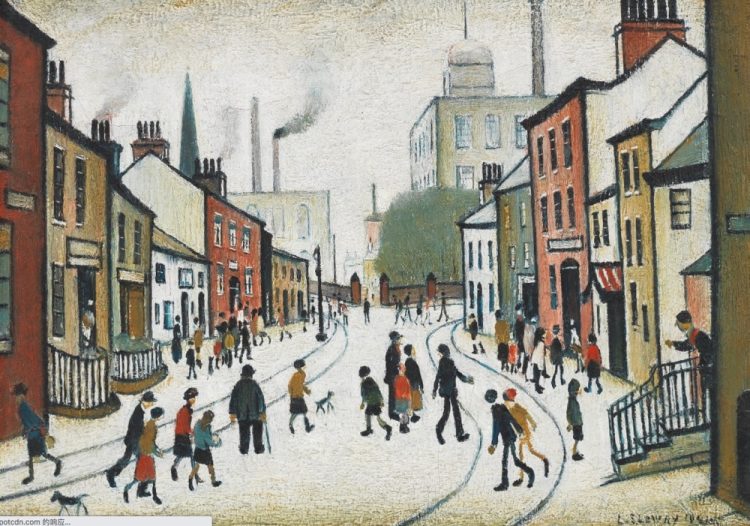It is for his paintings of people and the industrialised north that Lowry is best known, and it is easy to see through paintings such as Street Scene how the artist gained a unique place in the conscience of British collectors. Having been born in Manchester, a focal point of industrial Britain, Lowry’s exposure to a deeply urban landscape was guaranteed. A career as a rent-collector ensured that he would regularly wander the streets surrounded by the mills and factories of the great metropolis and the life brimming within it. His genius was the ability to create his own unique artistic vision from the environment that engulfed him and had become imbued in his mind and sub-conscious.
According to Lowry, the preoccupation with his surroundings began when he missed a train from Pendlebury, the suburb his family had moved to in 1909. Lowry was to recollect ‘…as I got to the top of the station steps I saw the Acme Spinning Company’s mill, the huge black framework of rows of yellow-lit windows stood up against the sad, damp-charged afternoon sky…I watched this scene – which I’d looked at many times without seeing – with rapture’ (Judith Sandling and Mike Leber, Lowry’s City, A Painter and His Locale, Lowry Press, Salford, 2000, p.17). At this moment, an already apparent obsession with art became more focused and the foundations were laid for the prolific body of work that have endeared Lowry to the nation’s hearts ever since.
Dating from 1941, the present work hails from what is traditionally considered Lowry’s finest period and bears all the qualities of his most desirable work. The street runs through the centre of the busy composition giving a strong sense of perspective, order and space. The terraced housing, shops and movement of the people in the foreground creates an almost tranquil atmosphere as the street winds down towards the central gates, symbolic of the industry and work that lies beyond to support this community. Factory chimneys, a church spire and mill are all present and complete a series of rich iconography.
By cutting off the buildings at the canvas edges, Lowry reinforces a sense of space and continuity, as well as placing himself and us the viewer as close as possible to the street. This is purely for visual impact as Lowry, an intensely private man and quiet observer, was not inclined to mingle with the crowd or participate in the daily routine. The artist conveys so much with so little. Using just five colours – flake white, vermilion, Prussian blue, black and yellow ochre, he memorably evokes the bustling atmosphere of a street and its surroundings.
The setting for Street Scene is, typically, unidentifiable. It has been well documented how Lowry’s paintings were often fantastical constructions, taking various elements such as factories, streets, bridges, chimneys from different places (including, sometimes, his imagination) and bringing them together on canvas to produce a purely fictional and idealised view of a town or city. As in the case of Street Scene, this gave Lowry the freedom to manipulate a composition to his liking for added visual impact. Whilst indisputably a Manchester man, Lowry found time to travel to smaller towns around the country such as Berwick. The seemingly calm and arguably provincial nature of the street in this picture may well relate to his experience of such locations.
The present work showcases Lowry’s artistic range and is an exceptional portrayal of his most beloved subject. Street Scene embodies Sir Herbert Read’s singular statement that ‘Lowry is original, and even revolutionary in his vision. No one else to my knowledge has been so sensitively aware of the poetry of the English industrial landscape’.
















































